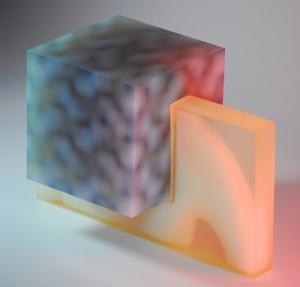If you’re not familiar with the concept of a voxel, it’s basically a three-dimensional version of the pixel from the digital imaging world.
 The word itself is meant to describe what designers call a “volume pixel,” and each one represents the singular attributes of a 3D object which includes many such units. The information in a voxel can describe the physical location of the unit, its color, or even specify material properties for that unit.
The word itself is meant to describe what designers call a “volume pixel,” and each one represents the singular attributes of a 3D object which includes many such units. The information in a voxel can describe the physical location of the unit, its color, or even specify material properties for that unit.
Developers Panagiotis Michalatos and Andrew (Andy) Payne have coded a stand-alone voxel modeling engine they call Monolith, and they say it offers “a new paradigm where objects are defined as a dense representation of material properties throughout a 3D volume.”
Michalatos is an architect and assistant professor in architecture at the Harvard Graduate School of Design who has worked in computational design research for the London-based structural engineering firm AKT. He and a colleague, Sawako Kaijima, developed a range of software applications for structural engineering methods in design.
Payne is an architect and Senior Building Information Specialist at CASE who earned his doctoral degree from Harvard’s Graduate School of Design. His research work has included embedded computation, parametric design, robotics, microcontrollers, and 3D printing. He’s also the co-author and lead developer of Firefly – the software plugin which acts as a bridge between the CAD environment of Rhino/Grasshopper and physical input/output devices like Arduino, web cams, mobile phones, and game controllers.
The pair were inspired to create Monolith when they realized that most 3D CAD applications are incapable of handling the spatial variations in material properties. The pair say many design applications were built to deal with a surface modeling paradigm which represents a ‘solid’ object as one enclosed by a set of discrete boundaries, but Monolith was designed to interact with the new class of 3D printers which make use of multiple print heads which can deposit different types of resin or other materials within a single build volume.
Their Monolith software allows the values for each “voxel channel” to be defined by a scalar function used to define a density value for each XYZ coordinate in a given space, and those channels hold the promise of a world of variations.
The voxel channels can act as controls for everything including points, lines, curves, and boxes, effects you may be familiar with from 2D image processing applications like color variations and even Gaussian blur effects.
In addition to its creation features, Monolith can also export mesh files in various formats including stereolithography (.STL), VRML 2.0 (.WRL), and Rhino (.3DM) files.
 And the list goes on and on as the package includes topology optimization, and modes to allow a designer to extrapolate the Von Mises and Principal stress distributions of materials and even simulate the deflection characteristics of a material under loading conditions.
And the list goes on and on as the package includes topology optimization, and modes to allow a designer to extrapolate the Von Mises and Principal stress distributions of materials and even simulate the deflection characteristics of a material under loading conditions.
What it all means in practice is a software tool capable of manipulating three-dimensional objects in a way that provides unprecedented access to the building blocks of those objects at the most basic level – the voxel.
What do you think of this new 3D software tool for developers and technicians? Can you see yourself using Monolith to design objects for 3D printing? Let us know in the Monolith forum thread on 3DPB.com.
Subscribe to Our Email Newsletter
Stay up-to-date on all the latest news from the 3D printing industry and receive information and offers from third party vendors.
You May Also Like
3D Printing Financials: Fathom Struggles in Financial Quicksand During Critical Transition
Facing a year of key transitions and financial pressures, Fathom (Nasdaq: FTHM) has filed its annual report for 2023 with the U.S. Securities and Exchange Commission (SEC). The document outlines...
Latest Earnings Overview for Australian 3D Printing Firms Titomic and AML3D
Australian 3D printing manufacturing firms Titomic (ASX: TTT) and AML3D (ASX: AL3) reported their financial results for the period from July to December 2023, marking the first half of their...
3D Printing Webinar and Event Roundup: April 7, 2024
Webinars and events in the 3D printing industry are picking back up this week! Sea-Air-Space is coming to Maryland, and SAE International is sponsoring a 3D Systems webinar about 3D...
3D Printing Financials: Unpacking Farsoon and BLT’s 2023 Performance
In the Chinese 3D printing industry, two companies, Farsoon (SHA: 688433) and Bright Laser Technologies, or BLT (SHA: 688333), have recently unveiled their full-year earnings for 2023. Farsoon reported increases...
































